Exhibit 99.1

Chairman’s Address
EMBARGO: 10.00AM
Wednesday 15 September 2004
Check against delivery
| |
|
|
Address by Meredith Hellicar
Chairman
James Hardie Industries
|
|
For media enquiries please contact John Noble on
Tel: 61 2 8274 5206 Mob: 0407 000 040. For
investor/analyst enquiries please contact Steve Ashe on
Tel: 61 2 8274 5246 or Mob: 0408 164 011 |
To the company’s Annual Information Meeting
15 September 2004
Ladies and Gentlemen, the last six months have been extraordinarily difficult
for James Hardie. To say otherwise would be to deny reality, and to be less
than frank with you.
Extraordinarily difficult times produce challenges of great significance, and
enormous consequence.
This has been true for James Hardie and I believe that your Board is prepared
to meet and resolve these challenges. In so doing, may I acknowledge the
immense contribution of our previous Chairman, Alan McGregor and wish him, and
his wife, Skye, well on your behalf. As you know, due to very serious ill
health, Alan was forced to resign both as Chairman and a Director last month
and our thoughts are with him.
As your new Chairman, I begin by giving you this commitment: While endeavouring
to lead this great company to continuing commercial success, I will seek to be
candid with you, our shareholders, with our employees and with the wider
community, on all issues that relate to James Hardie’s contribution and role as
a corporate citizen, whether it be in Australia, North America or Europe.
I am confident that James Hardie will emerge from its current difficulties a
better and more robust company, due in large part to the performance of our
employees at many levels. But is also a reflection of the support that you, our
shareholders, have shown in the company. This has been pivotal in enabling
James Hardie to respond to the demands and dilemmas of recent times and we
thank you for that.
I now turn to the events of the recent past, before looking forward to our
preparedness to play a positive role for the future.
While we have continued to record excellent business performance, much of the
last year for James Hardie has been dominated by the NSW Special Commission of
Inquiry in Australia, examining the asbestos liabilities of former James Hardie
group companies, and the establishment of the Medical Research and Compensation
Foundation.
Commissioner Jackson is due to hand his report to the NSW Governor by 21
September, although we don’t know when it will be available publicly. We look
forward to this report providing a solid base from which we can move forward.
I should note here that — among a number of baseless claims — we have been
accused of arranging this meeting to occur prior to the release of the
Commissioner’s report. Instead, the timing is dictated by our Articles of
Association.
We’re required to hold this meeting in the week prior to our AGM. In fact, when
we delayed this meeting beyond our usual August timeframe, we thought the
Commissioner’s report — originally due in June — would have been available.
Let me be clear: if there is sufficient cause to call a further shareholder
meeting following the report, for example to approve funding a scheme for
future claimants as proposed to the Commissioner by James Hardie, we
will call
such a meeting.
We’re not in a position to speculate what the Commissioner might recommend.
That’s why this AIM and Friday’s AGM have no formal agenda items relating to
the Commission, or relating to James Hardie’s proposals to the Commission on
future funding for asbestos claimants. Of course, you are welcome to ask
questions on this issue at this meeting.
In seeking to address many of the questions that you have already sent us, and
pre-empt some that may arise from the floor today, I’d like to talk about how
James Hardie came to be the subject of this Inquiry, the issues we are dealing
with, and how we propose to meet the very real needs of claimants against our
former subsidiaries — as well as continue to ensure the company’s growth and
success for the benefit of all stakeholders.
I’d like to start by reiterating my recent public statements that your Board
deeply regrets:
| • |
|
that people were injured by asbestos products manufactured by former subsidiaries of James Hardie, and |
| |
| • |
|
that these people, and their families, have suffered as a result of this exposure, and |
| |
| • |
|
the stress and uncertainty caused because the Foundation we set up to meet their claims has proven to have insufficient
funding. |
While we can never possibly understand the full extent of their experience,
subject to the views of Mr Jackson and the NSW Government, we plan to put to
shareholders a proposal that ensures that the compensation to which these
people are entitled continues to be provided in a manner that is speedy, fair
and equitable.
2
At the same time, your Board recognises its duty to you, our shareholders and
the duty owed to employees. We have received many letters and comments, and
have spoken personally to a number of you, so we understand your concerns. We
also understand that this has been a very difficult time for all those
associated with the company, and extend our thanks to our many stakeholders for
their patience and support.
I acknowledge that the company’s liability to asbestos claimants is a very
emotional and heated issue.
Some criticisms have caused us to ask necessary questions of ourselves.
However, the controversy has also led to some extreme statements being made
about James Hardie. Some of these are simply wrong, and they ignore historical
or legal facts.
We believed it was inappropriate for us to respond to all these claims through
the media while the Commission hearings were ongoing, but we recognise that the
media has been the main source of information for most people.
Now that the hearings are finished, we’re in a position — without pre-empting
Mr Jackson’s report — to review with you some of the facts about James Hardie’s
association with asbestos.
James Hardie group companies first started manufacturing products containing
asbestos in the 1920s. Brake products were produced from 1930. In 1937, James
Hardie and Coy was incorporated as a subsidiary and from that point on was
responsible for the production of asbestos cement building products.
Other companies within the group had leading positions in a wide range of
industries. Over time, these included tires, security, PVC pipes, fire
protection and electrical contracting.
In the following years, the use of asbestos was very widespread. In Australia,
it was used in thousands of products, by hundreds of companies, and by
significant government entities.
Information about the dangers posed by the different forms of asbestos grew
gradually and, as the connection between asbestos and disease became
established, most companies, including James Hardie, first
controlled exposure,
then stopped using it.
James Hardie ceased using blue asbestos in 1968 and then phased out the use of
all other forms of asbestos, so that our insulation was asbestos free by 1974;
our building products by 1983; and pipes by 1986. Our brakes business was
asbestos-free by 1986 and sold in 1987.
Two James Hardie group subsidiaries, Amaba (the company that formerly produced
brake products) and Amaca (the company that formerly produced building
products), figure prominently amongst the defendants against whom claims are
currently made by asbestos disease victims.
There have been a lot of assertions made about the extent of James Hardie’s
liabilities, and, from your questions, this appears to be another area of
considerable and legitimate inquiry.
3
Expert actuarial evidence by KPMG Actuaries presented to the Commission of
Inquiry estimated the liabilities of the former James Hardie subsidiaries to be
$1.573 billion as at 30 June 03.
More recently, an actuarial and insurance industry review by KPMG estimated
that, at present, the total cost of Australian asbestos liabilities may exceed
A$8.2 billion, although they acknowledged the uncertainty in predicting a
definitive figure, owing to an evolving legal and medical environment.
On the basis of that estimate, and the actuarial advice prepared by KPMG as
expert evidence before the Commission, James Hardie’s former subsidiaries would
represent approximately 19% of the total asbestos liabilities in the Australian
market.
In providing this figure I’m not attempting to downplay our historic
involvement with asbestos, or diminish responsibility for injuries caused by
the products manufactured by our former subsidiaries.
But whilst the James Hardie group had a major share in the asbestos cement
building materials market, asbestos was widely used in a range of areas — such
as fire-proofing, textiles and fabrics, ship-building, paints and adhesives -
and many products used in those applications were not supplied by James
Hardie.
It’s also important to note that the fibre cement products that James Hardie
produces today do not contain asbestos.
James Hardie pioneered the development of asbestos-free substitute products,
which it began selling in the early 1980s. These new products, called fibre
cement, are now used all around the world and have been the core focus of our
business, and the source of our returns, for more than twenty years.
Rapidly increasing demand for these fibre cement products was one of the
factors in our decision to create the Medical Research and Compensation
Foundation in 2001.
By the late 1990s, it was clear that James Hardie’s largest growth prospects
were overseas, particularly in North America. It was also apparent that
overseas investors and debt providers would be less inclined to invest in
James Hardie if we continued to have on-going asbestos liabilities within
the balance sheet of group companies.
This fact did not make us any less sympathetic to the plight of victims of
asbestos related diseases.
On the contrary.
Seeking to provide for their needs and, at the same time, remove the liability
from James Hardie’s balance sheet to enable the company to pursue growth
opportunities, the former Australian holding company, James Hardie
Industries Limited (JHIL) created the Foundation to operate independently
of James Hardie and compensate individuals injured by asbestos products
produced by the two former James Hardie Group companies.
Taking into account actuarial advice commissioned at the time, the Foundation
was established with $293 million of cash funds and income–producing
assets.
4
As you know, it has been the position of the company- and it remains its
position – that, at the time, and contrary to what is now alleged to be
the company’s motivation, the Board of JHIL believed this would be
sufficient funds to meet all future claims.
James Hardie also provided the Foundation with funds for medical research
aimed at finding treatments and cures for asbestos-related diseases and
continue to be involved in this vital area.
With the establishment of the Foundation in 2001, the Board of JHIL believed it
had achieved the twin goals of providing properly for future claimants as well
as separating our asbestos liabilities from the balance sheet to enable future
international growth in James Hardie for the benefit of shareholders.
Much media discussion during the recent Inquiry has characterised the decision
to redomicile James Hardie to The Netherlands as being an attempt to put the
company’s assets beyond the reach of claimants.
Quite separately from the decision to establish the Foundation, it became clear
to the Board of JHIL that shareholders were not going to receive the maximum
benefits from James Hardie’s growth and financial success in the United States
under the then current corporate structure.
This issue was driven by the company’s increasing global focus and
international financial tax efficiencies. It was not driven by a desire to run
away from asbestos liabilities.
In essence, we needed to find a more effective corporate structure to deal with
the fact that an increasing proportion of James Hardie’s returns were coming
from the United States, but had to be distributed to predominantly Australian
shareholders.
The Board of JHIL decided that the best solution was to re-domicile the
company, specifically using a Dutch financial risk reserve regime that exists
between the USA and The Netherlands.
As a result, in October 2001, it implemented a scheme of arrangement which
created a new James Hardie group parent company in the Netherlands.
The restructure and the creation of the Dutch parent, James Hardie Industries
NV, has increased the financial efficiency of the group, and has better-placed
the group for future growth.
The Financial Risk Reserve Regime delivered a benefit of US24.8 million in our
last financial year, taking the total benefit to date to US$39.3 million.
While I am on the subject of the Dutch Financial Risk Reserve Regime and the
tax treaty between the US and The Netherlands, a protocol to the treaty has
been signed and we expect that the US Congress will ratify this, later this
year.
The company will either satisfy the new requirements for treaty benefits, or
implement alternative arrangements. We are confident of a good outcome, but it
might take some time to understand the issues and make any adjustments
required.
5
Having a Dutch parent company is not unique to the James Hardie group.
I’m advised that The Netherlands is a well-established domicile for more than
250 companies that are listed on the New York Stock Exchange.
Importantly, moving to the Netherlands did absolutely nothing to change the
legal liabilities of the James Hardie companies, nor the ability of claimants
to pursue those liabilities. We voluntarily agreed to submit ourselves to NSW
jurisdiction.
When the Directors of the Foundation wrote to us informing us that the fund
may experience a significant shortfall, our response was consistent with
the approach that the financial position of the Foundation and its
subsidiaries had become that of a separate enterprise. At the time, we
did not identify an appropriate way by which we could offer further
funding.
In retrospect, we could have responded differently, and more quickly.
We knew we had to carefully consider all the ramifications of these
circumstances: the potential impacts on future claimants and their
families, on the Foundation, on the company and shareholders, and on us as
Directors.
As directors, we sought to maintain both a legal and moral perspective,
whilst bearing in mind our fiduciary responsibilities to you, our
shareholders, and our obligation to act in the best interests of the
company as a whole.
In considering the sometimes competing – or even conflicting — requirements
of the law, community expectations and our own moral precepts, we did not
respond with offers of funding support for any shortfall of the
Foundation. Understandably, this worried the Foundation and potential
claimants and led to a perception that we were seeking to “wash our hands”
of the Foundation’s predicament.
In October 2003, the directors of the Foundation announced that revised
actuarial advice predicted the estimated future funding shortfall would in
fact be $700 million.
Those with an interest in the issue of asbestos diseases and compensation made
increasing calls for the NSW Government to intervene and, in February this
year, the State Government established the Special Commission of Inquiry.
When the Inquiry was announced, we welcomed it as an open, independent forum
that could take evidence and provide information that would make it
possible to separate understandable emotion from the facts.
We also decided to deal with
the issues to be addressed, in the Commission,
and not in the media. We sought at all times to be open, honest, helpful
and respectful of the Commission and have complied with all requests that
the Commission has made of us.
Whilst we have vigorously defended the legality of the company’s actions, when
we received updated actuarial advice from our new actuaries, KPMG,
verifying what the funding shortfall was likely to be, we volunteered
funding, subject to shareholder approval, for a suitable and effective
scheme to compensate future claimants against our former subsidiaries.
6
Copies of our submissions and submissions in reply are available on our
website, and I encourage you to read these to gain an understanding of the
positions we submitted to the commission.
Our actions are not those of a company that has run away to the Netherlands
or is seeking to avoid its broader community obligations.
What is this so-called Scheme Proposal?
It is the case — as far as we are aware — that every person who is legitimately
entitled to compensation to date has received it.
Our objective, in seeking to develop the Scheme Proposal, is to ensure that
this continues to be the case, whilst retaining a perspective on the best
interests of our shareholders.
As I mentioned, faced with the new actuarial information, which we presented to
the Commission, on 14 July, your Board announced that we would recommend that
shareholders approve the provision of additional funding to enable an effective
statutory scheme to be established to compensate all future claimants for
asbestos-related injuries caused by former James Hardie subsidiaries.
We argued in the Commission that such a scheme would provide certainty of
compensation to claimants and would also greatly reduce a number of current
costs which do not go to claimants.
We also requested a safeguard for you, our shareholders, that we would require
any final funding proposal to be put to you, so that you can understand the
arguments for and against it, and make an informed decision.
We’ve provided the Commission with submissions setting out the key principles
of the proposed scheme, specifically:
| |
• |
|
We’re advocating a simple and expeditious procedure to assess
claims, so that claims are processed more quickly and legal and other
expenses which are not part of the compensation provided to claimants,
are removed or considerably reduced. |
| |
| |
|
|
We do not accept, as some of our critics argue, that an outcome of this
process should be the enrichment of plaintiff lawyers. |
| |
| |
• |
|
We have not assumed caps on payments to claimants. |
| |
| |
• |
|
We recognise that any scheme described today will have to address
the needs of potential new claimants, who are yet to be affected by
asbestos and who are not currently identified in actuarial estimates. |
So, let me try to sum up where we are today.
Firstly, we have established a Board Committee to focus specifically on the
Inquiry outcomes, including the important challenge of finding a funding
solution. In addition to myself as Chairman, the committee consists of Donald
McGauchie and Michael Gillfillan.
7
Specifically, our tasks include:
| • |
|
Reviewing the Commissioner’s report, and recommending to the Board
appropriate actions, including remedial actions, in response to its findings;
and |
| |
| • |
|
On behalf of the company, overseeing any developments or discussion of
suitable arrangements to ensure all legitimate claimants receive fair and
equitable compensation and taking any recommendations to the Board and,
ultimately, to shareholders for approval. |
This last point — shareholder approval — is important.
If Commissioner Jackson recommends a scheme, if the government accepts this
recommendation, and if a suitable scheme can be developed, we will put the
proposed funding details to you, our shareholders so that you have an
opportunity to review the impact of any recommendation on the future of the
company, and satisfy yourselves that it is viable and appropriate.
I want to reassure you that your Board is focussed on exploring all potential
solutions and on finding a solution that
| • |
|
addresses, in an affordable manner, the issue of funding compensation for victims of asbestos related disease caused by
James Hardie’s former subsidiaries, |
| |
| • |
|
addresses the concerns of the community, and |
| |
| • |
|
allows us to meet our responsibilities to you, our shareholders, and to our employees. |
Secondly, as announced last Friday, given allegations raised in the Inquiry,
and in order to assist in completion of the preparation and filing of our
accounts in the United States, the Audit Committee of the Board has
commissioned an internal investigation, conducted by independent legal
advisors, to investigate allegations of illegal acts and any potential impacts
on the financial statements.
We expect this internal inquiry will not be completed until the company has
access to the Report from the Commissioner.
This is why we have deferred a vote on Item 1 at the AGM. The Board does not
consider it appropriate to seek shareholder adoption of the Dutch GAAP accounts
until these matters are resolved.
Thirdly, in my newly-appointed role as Chairman, I plan to address the issues
of Board renewal and the restoration of the company’s reputation and standing
in business, and in the community.
In doing this, I will seek to ensure the composition of the Board will continue
to have Directors from Australia, the USA and Europe, with a mix of relevant
experience and skills.
At this year’s Annual General Meeting, shareholders are being asked to elect
John Barr to the Board. John brings to us wide-ranging management experience
gained over 30 years in corporations in our major market of North America.
8
He challenges our thinking and brings a practical, no-nonsense perspective to
the key issues facing the company. John’s career demonstrates his commitment
to building businesses that can sustain sound performance over the long term.
Our Board renewal process will not stop with John and I look forward to the
continuing development of the James Hardie Board so that it can lead the
company into a stronger, more secure future.
Finally, we acknowledge the changing demands of the wider community in which we
seek to operate.
The Board recognises that James Hardie must be even more energetic as an active
corporate citizen, not simply to rebuild our reputation, but to underline our
willingness to participate constructively and creatively in the social fabric
of the communities in which we play a part.
The company’s reputation is a matter of vital concern to me, and to the Board
as a whole, as well as to our shareholders and employees and I give you our
commitment that we will be working to restore it. But this will take time,
because the issues we seek to address are not simple.
James Hardie is made up of people who are seeking an acceptable balance between
what the community reasonably demands of us, what our shareholders legitimately
expect of us, and what the law requires of us.
It is only because we understand the implications — and inter-relationships -
of all these obligations that we have:
| • |
|
proposed the funding solution we have, and |
| |
| • |
|
proposed that this scheme be put to a vote of our shareholders. |
We are confident that you share our commitment to find a solution that will
meet all the obligations that are expected of us.
Indeed, it’s only because we have a highly successful business that we believe
we can fund such a scheme in an affordable manner, rather than limiting
claimants to partial or no payments, and shareholders to no returns.
We will also, importantly, seek to ensure that James Hardie continues to
perform successfully as a business, so we can fund the offer that is made to
potential compensation claimants, while achieving appropriate returns for
shareholders.
In this regard, I’d like to comment briefly on the very positive results
achieved in the James Hardie business last year:
| • |
|
net sales increased 25%; |
| |
| • |
|
gross profit was up 23%; and |
| |
| • |
|
EBIT1 increased 24% to US$172.2 million. |
I thank our Board, our managers, and our employees for the hard work and
enthusiasm with which they contributed to these outstanding operating results.
9
These results reflect continued strong growth in our core markets in North
America, improved performance in the Asia Pacific region, including Australia,
improvements in South America, and our pursuit of growth opportunities in new
markets such as Europe, and through new products, such as Roofing.
Your Board believes that the company is well-positioned to continue to develop
its business with new products and markets, as well as increased penetration in
its existing markets.
We will also continue our focus on Research and Development. Much of this is
carried out in Australia, at our centre in Rosehill here in Sydney.
Our investment in R&D enables us to develop and produce products that our
competitors have not matched, and build and commission manufacturing plants at
less cost than our competitors.
Ladies and Gentlemen, I conclude my remarks by reaffirming my opening
statements.
James Hardie remains a great company but, obviously, we have learned much that
is important to our future from the experiences of the recent past.
We have expressed our profound regret for circumstances in which the company
has caused suffering, uncertainty or stress to people injured by products made
by our former subsidiaries. We are looking to a future where we can make a
substantial contribution to comprehensively resolving the difficult issues
surrounding those circumstances.
We have committed ourselves to seeking your approval for a scheme which will
provide proper compensation for those who are suffering as a result of their
exposure to asbestos products manufactured by former James Hardie subsidiaries,
as well as being affordable for the company and acceptable to our shareholders.
We acknowledge that much depends on Mr Jackson’s findings. Much depends also on
the response of the NSW Government.
But no-one should be in any doubt about James Hardie’s preparedness to work
purposefully with all applicable authorities to achieve a resolution.
Nor should anyone be in any doubt about the company’s vigorous approach to our
future. Despite the current pressing issues, it is a future of opportunity
which we may anticipate with hope, and confidence.
End.
10
Investor and Analyst Enquiries:
Steve Ashe — Vice President, Investor Relations
Telephone: 61 2 8274 5246
Mobile: 0408 164 011
Email: [email protected]
Media Enquiries:
John Noble
Telephone: 61 2 8274 5206
Mobile: 0407 000 040
Email: [email protected]
Facsimile: 61 2 8274 5218
www.jameshardie.com
1EBIT - EBIT is defined as operating income. We believe EBIT to be relevant and
useful information as it is a primary measure used by our management to measure
the operating profit or loss of our business. EBIT is one of several metrics
used by our management to measure the cash generated from our operations,
excluding the operating cash requirement of our interest and income taxes.
Additionally, EBIT is believed to be a primary measure and terminology used by
our Australian investors. EBIT should be considered in addition to, but not as
a substitute for, other measures of financial performance reported in
accordance with accounting principles generally accepted in the United States
of America. EBIT, as we have defined it, may not be comparable to similarly
titled measures reported by other companies.
EBIT, as used in this document, is equivalent to the US GAAP measure of
operating income.
11

|
Annual Information Meeting
15 September 2004
All results are for continuing operations unless otherwise stated
|
Good morning.
I am pleased to have the opportunity to talk to you about the operating
performance of the business for the last year.
I know the major issues for the company today are the Inquiry, related
compensation issues, and putting in place a permanent resolution.
However, it is vital that we also continue to perform strongly and grow, in the
interests of all stakeholders.
Meredith has covered the issues relating to the inquiry, and I will focus on
the operating performance of the business.
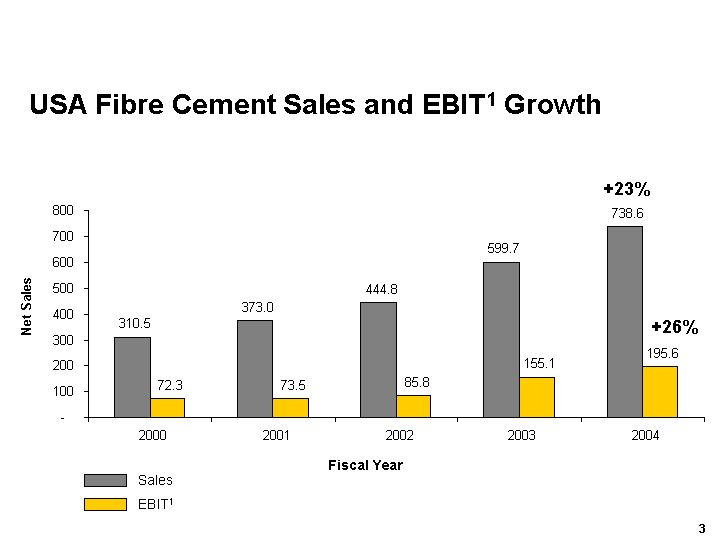
|
USA Fibre Cement Sales and EBIT1 Growth
Sales
EBIT1
+23%
+26%
|
As Meredith mentioned in her address, we had a year of very strong performance.
USA Fibre Cement
Our largest market is the USA and our USA Fibre Cement business continued its
outstanding performance, finishing the year with increases in net sales of 23%
and EBIT1 of 26%.

|
USA Fibre Cement
Volume Growth 2004 245mmsf1 +19%
0
200
400
600
800
1000
1200
1400
1600
1800
2000
90
91
92
93
94
95
96
97
98
99
00
01
02
03
04
Volume (MMSF1) / Starts (000's Units)
$0
$125
$250
$375
$500
$625
$750
Revenue (USDM)
Volume
|
One of the most pleasing features of our North American performance was the
growth in demand for fibre cement. Over the course of the year, we grew our
sales volumes by around 245 million standard feet or 19%.
This performance continued what has been very strong growth since we started
business in the USA in 1988 – with a Compound Annual Growth Rate since that
time of around 39%.
We differentiate between growth that occurs because of market movements, and
growth that occurs via penetration into established markets.
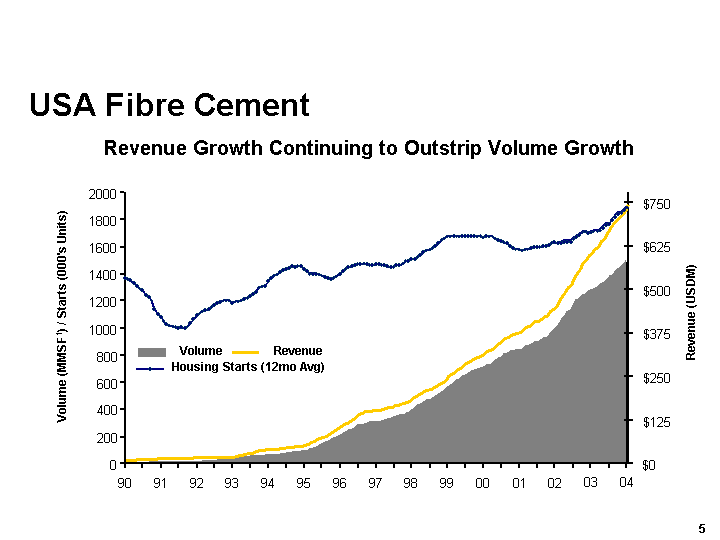
|
USA Fibre Cement
Revenue Growth Continuing to Outstrip Volume Growth
0
200
400
600
800
1000
1200
1400
1600
1800
2000
90
91
92
93
94
95
96
97
98
99
00
01
02
03
04
Volume (MMSF1) / Starts (000's Units)
$0
$125
$250
$375
$500
$625
$750
Revenue (USDM)
Volume
Revenue
Housing Starts (12mo Avg)
|
Around two-thirds of last year’s growth – or 155 million standard feet – is our
estimate of growth through penetration into existing markets rather than from
general market growth. Growth through penetration has been the predominant form
of growth for many years and reduces our exposure to cyclical movements in our
end-markets. This chart shows how our growth in both revenue and volume has
outstripped growth in housing starts.
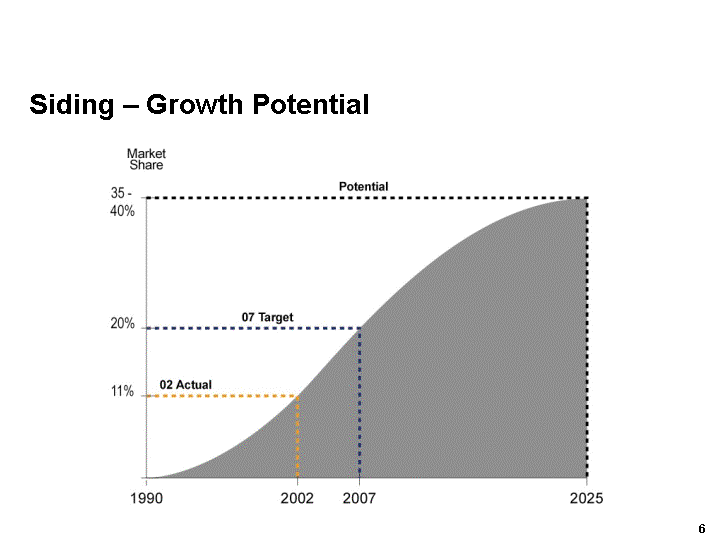
|
Siding - Growth Potential
Siding - Growth Potential
|
We grew demand for both interior and exterior products. Our share of these
markets is still quite low, relative to the potential terminal market share,
which provides us with significant long-term growth potential. Here is an
example that might represent our potential in siding.

|
Reno Plant Construction
Reno Plant Construction
Reno Plant Construction
Reno Plant Construction
Reno Plant Construction
|
During the year we began constructing our plant in Reno, Nevada, with 300
million square foot annual design capacity. This plant has one line and will
produce 50% more than our previous largest single lines. The Reno plant will
supply rapidly-growing demand in the west coast region of the United States.
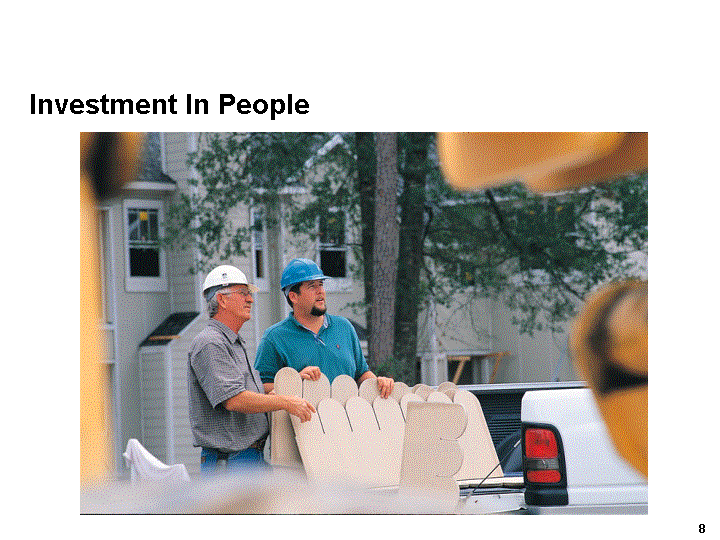
|
Investment In People
Investment In People
|
We continue to invest in people and infrastructure to support further growth.
Over the year, we added a significant number of employees, with an emphasis on
sales and marketing roles. Through activities such as this, we are building a
strong foundation for future growth.
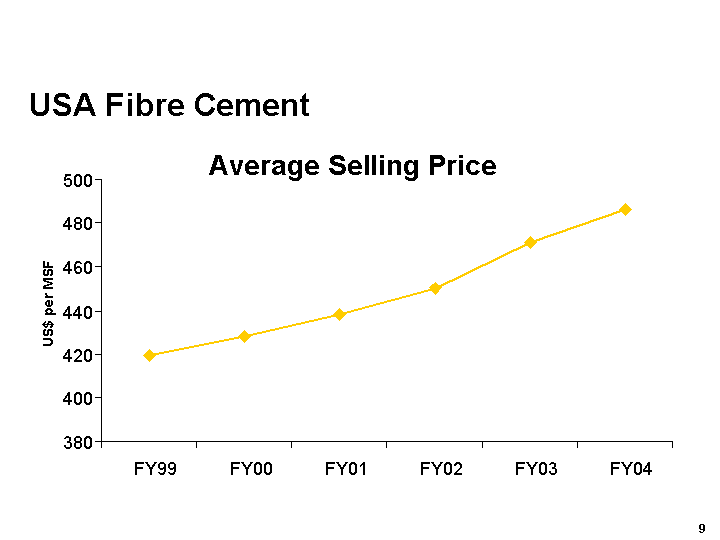
|
USA Fibre Cement
Average Selling Price
380
400
420
440
460
480
500
FY99
FY00
FY01
FY02
FY03
FY04
US$ per MSF
|
Our average net selling price improved 3% on the prior year and sales of more
differentiated and higher-priced products continued to grow well. This trend
has been evident for some years.
Longer-term, we expect modest, average net selling price improvements to
continue as sales of higher-priced products grow at a faster rate than that of
our more established products.
We continue to achieve very
strong EBIT1 performance improvement and our
EBIT1
margin continues to be in a range well above our 20% long-term target for the
USA Fibre Cement business.
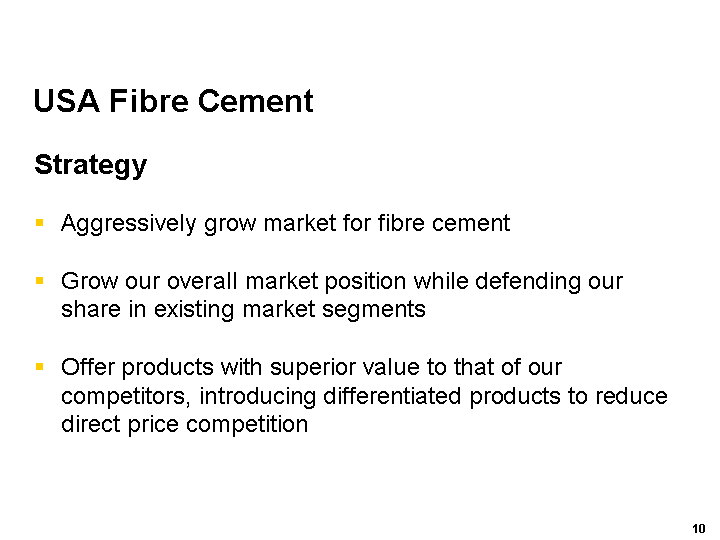
|
USA Fibre Cement
Strategy
Aggressively grow market for fibre cement
Grow our overall market position while defending our
share in existing market segments
Offer products with superior value to that of our
competitors, introducing differentiated products to reduce
direct price competition
|
Our USA Fibre Cement business strategy is very successful, is achieving strong
growth and strong returns for the company, and is therefore unchanged. We seek
to:
| |
– |
|
Aggressively grow the market for fibre cement; |
| |
| |
– |
|
Grow our overall market position, while defending our share in existing market
segments; |
| |
| |
– |
|
Offer products with superior value to those of our competitors, introducing
differentiated products to reduce direct price competition. |

|
Asia Pacific Performance Improvement
+38%
|
I would now like to talk about our Asia Pacific business.
Asia Pacific Fibre Cement
Our Asia Pacific Fibre Cement business recorded very solid performance, with
net sales up 2% in Australian Dollars and 26% in US dollars.
Sales volumes were up 9%, and EBIT1 was up 12% in Australian dollars and up 38%
in US dollars — reflecting a significant positive exchange rate movement.
Our strategy in Asia Pacific remains intact, because it is delivering solid
performance and growth in markets such as Australia and New Zealand that do not
have high levels of underlying growth.
Despite this, we continue to see growth potential in Australia and New
Zealand, where fibre cement still accounts for only a small share of the total
building products market. Unlike North America, which has a tradition of using
planks, the Australian housing market is traditionally a brick market.
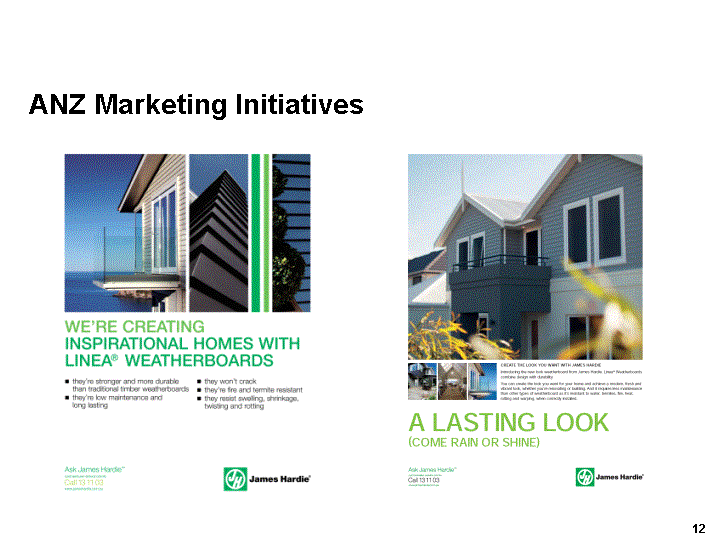
|
ANZ Marketing Initiatives
ANZ Marketing Initiatives
ANZ Marketing Initiatives
|
We see this as a sound opportunity and our Australian and New Zealand
businesses have put in place a number of initiatives designed to encourage
designers, architects and homeowners to incorporate our lightweight building
materials into their designs, however any change in favour or our siding
products will occur gradually over time.

|
ANZ New Products
ANZ New Products
Linea(r) Weatherboards
Eclipsa(tm) Pre-painted
Eves
ConText(tm) Facade
System
|
We are pursuing increased sales, with a range of unique products and systems;
the slide shows some examples.
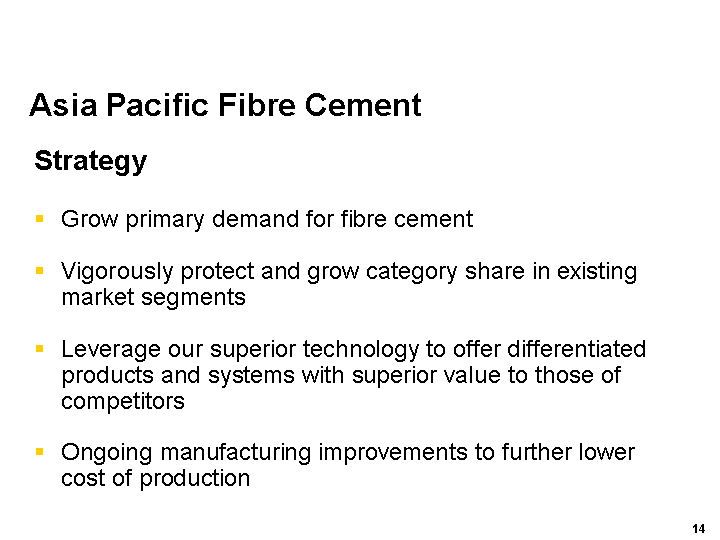
|
Strategy
Grow primary demand for fibre cement
Vigorously protect and grow category share in existing
market segments
Leverage our superior technology to offer differentiated
products and systems with superior value to those of
competitors
Ongoing manufacturing improvements to further lower
cost of production
Asia Pacific Fibre Cement
|
Because this strategy is proving to be successful for the company, our Asia
Pacific businesses will continue to:
| |
– |
|
Grow the primary demand for fibre cement |
| |
| |
– |
|
Vigorously protect and grow our category share in our existing segments |
| |
| |
– |
|
Offer differentiated products with superior value to those of our competitors |
| |
| |
– |
|
Continue to drive manufacturing improvements to lower the cost of production |

|
Other Fibre Cement
Chile Fibre Cement -
Key Points
Net sales up 139%
Full year EBIT1 positive
|
Chile Fibre Cement
Our Chilean business provides us with a small but profitable toehold in South
America.
Last year, the business delivered a strong performance, with net sales up 139%
in local currency and a full-year EBIT1 positive result. We achieved strong
penetration into a market that enjoyed a lift in domestic construction
activity.
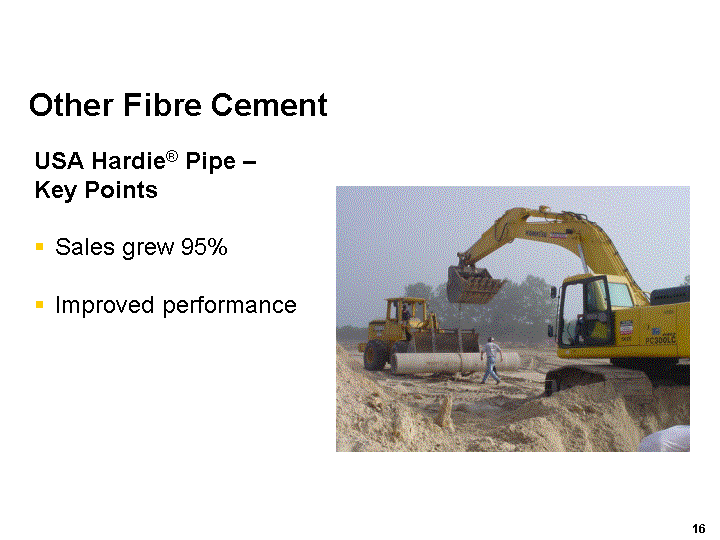
|
Other Fibre Cement
USA Hardie(r) Pipe -
Key Points
Sales grew 95%
Improved performance
Improved performance
Improved performance
Improved performance
Improved performance
Improved performance
Improved performance
|
Hardie® Pipe
Our USA Hardie® Pipe business achieved very strong net sales growth last year,
up 95%.
We continued to penetrate the Florida markets , and customers continued to
choose our fibre cement pipe over competing products.
We are improving performance in our pipes production plant, but costs are still
above the required levels. Average net selling prices improved slightly towards
the end of the year, but are still low and further price improvement is
required.
We made an EBIT1 loss in the USA Hardie® Pipe business, but have seen strong
improvement in the current year. We remain hopeful that we will be able to
prove up the US FRC pipe opportunity so that it is capable of delivering value
for shareholders in the future.

|
Europe
Completed first year
Growing revenue
Long term potential
|
Europe Fibre Cement
In Europe, our business has just completed its first year since start up. It is
very early days, but we have made acceptable progress and are growing revenues
in markets that offer us long-term potential. We are initially selling our
siding and backer products importing from the USA. A weaker US dollar is
reducing our import costs.

|
Artisan(r) Roofing
Artisan(r) Roofing
|
Artisan® Roofing
For some time, we have been developing a unique fibre cement roofing product.
We have now started to commercialise this technology, initially through the
development, and now with the launch, of a “thick butt wood shake product”.
The slide shows how the roofs made with it look. While this is an unusual look
in Australia, it is highly desirable in the USA where wood shakes were the
original roofing material.
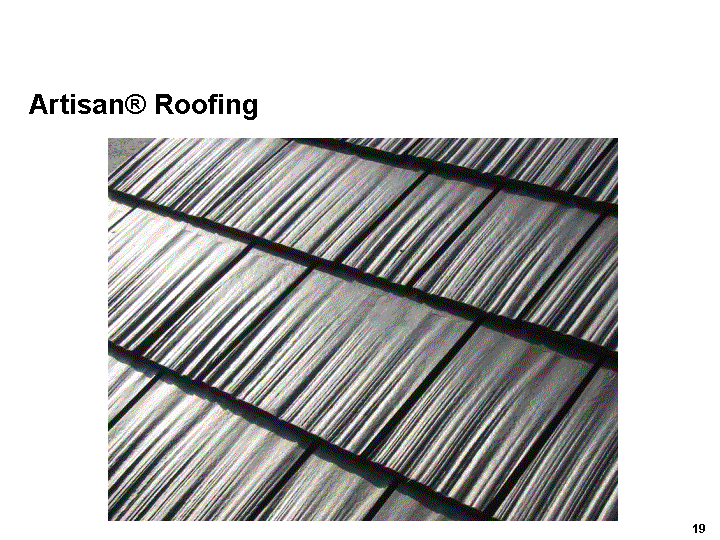
|
Artisan(r) Roofing
Artisan(r) Roofing
|
Our Artisan® Roofing business is making good progress refining the
manufacturing process in the pilot plant in Fontana, California. Trial
installations have been successful and we believe end-market interest in the
product is strong.
We are probably at least two years away from stepping-up our initial investment
to full commercial manufacture, assuming that the pilot plant continues to ramp
up successfully.
The end markets for roofing are large – larger than the siding markets, so
providing we can successfully complete development, there is a lot of potential
for growth.
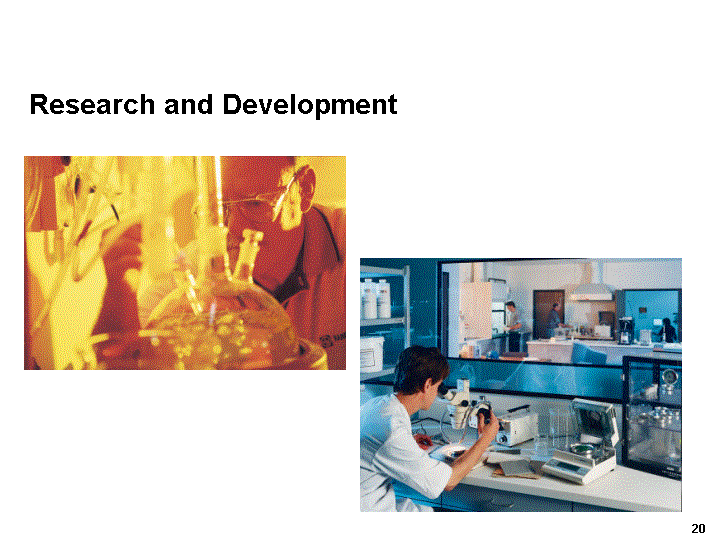
|
Research and Development
Research and Development
Research and Development
|
Research and Development
Research and Development continues to be one of the key investments we make in
our business and it is the key driver of our long-term growth and our ability
to sustain a competitive advantage.
We have Research and Development Centres here in Sydney, and in Fontana,
California. We employ over 110 scientists, engineers and technicians in the
areas of Core Research and Product & Process Development. Over 50% of our
scientists have advanced degrees, and 45% have worked for James Hardie for over
five years.
R&D gives us the highest return that we get from any discretionary expenditure.
Over the year, we spent US$17.6 million in our core and administrative R&D
activities and US$8.5 million in product development in our business units,
taking our total spend for the year to US$26.1 million, an increase of around
25% over the prior year.
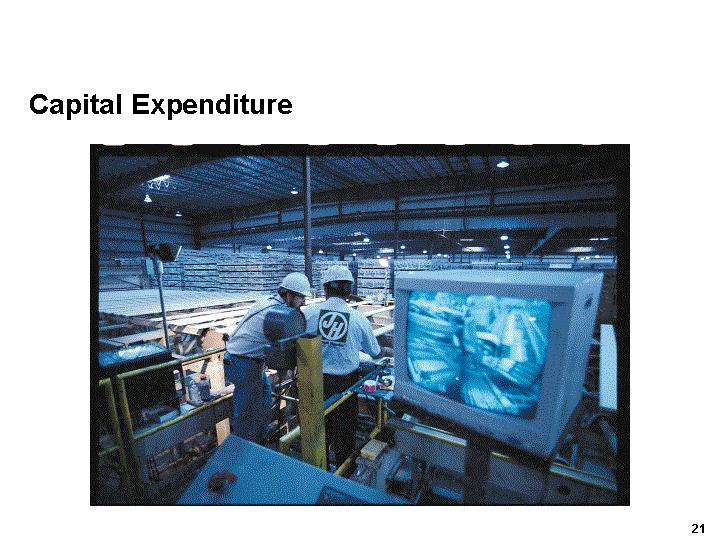
|
Capital Expenditure
Capital Expenditure
|
We also invested heavily in capital expenditure projects during the year,
spending US$74.1 million. The majority of this sum was spent in the United
States, and a significant portion was on growth projects including: the
pre-finishing and trim lines in Peru, Illinois; the Blandon, Pennsylvania
upgrade; the new factory in Reno, Nevada; and a second line at Waxahachie,
Texas.
In Asia Pacific, we upgraded the Rosehill, Sydney plant. Elsewhere, the major
spending was on the completion of the roofing plant in California and the paint
line in England for our European business.
The results I have been talking about are for the fiscal year ended the March
2004.
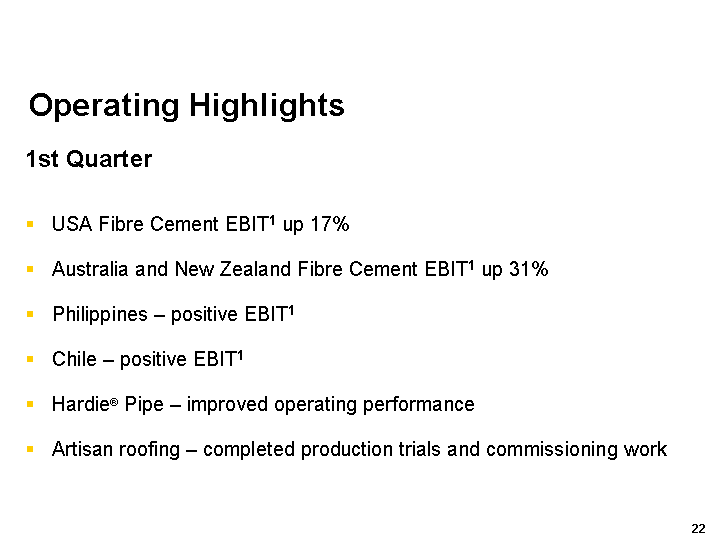
|
Operating Highlights
1st Quarter
USA Fibre Cement EBIT1 up 17%
Australia and New Zealand Fibre Cement EBIT1 up 31%
Philippines - positive EBIT1
Chile - positive EBIT1
Hardie(r) Pipe - improved operating performance
Artisan roofing - completed production trials and commissioning work
|
Since then, we have reported our results for the first quarter of Fiscal Year
2005 and I am pleased to advise that these demonstrate a continuation of the
strong results we achieved last year.
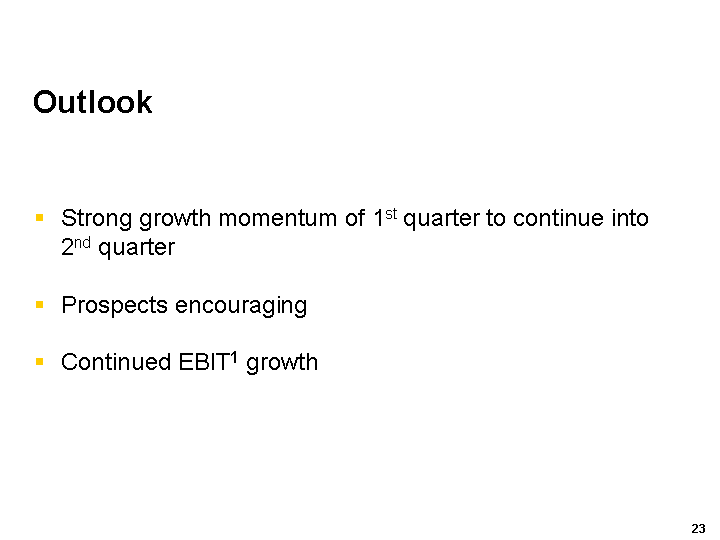
|
Outlook
Strong growth momentum of 1st quarter to continue into
2nd quarter
Prospects encouraging
Continued EBIT1 growth
|
Looking ahead to the remainder of the year the company believes the strong
growth momentum evident in the first quarter will continue during the second
quarter and the prospects for growth over the full year remain encouraging.
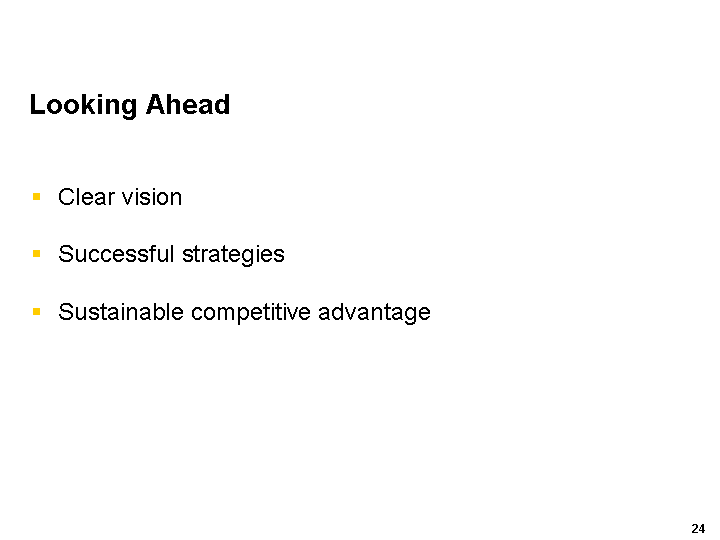
|
Looking Ahead
Clear vision
Successful strategies
Sustainable competitive advantage
|
We have many challenges to address as we continue to grow our business around
the world.
We have a clear vision to achieve this, and will combine this with successful
strategies which we have implemented over many years, and the sustainable
competitive advantage conferred by our fibre cement technology.

|
1Definitions
EBIT - EBIT is defined as operating income. We believe EBIT to be relevant and useful information as it
is a primary measure used by our management to measure the operating profit or loss of our business.
EBIT is one of several metrics used by our management to measure the cash generated from our
operations, excluding the operating cash requirement of our interest and income taxes. Additionally,
EBIT is believed to be a primary measure and terminology used by our Australian investors. EBIT
should be considered in addition to, but not as a substitute for, other measures of financial performance
reported in accordance with accounting principles generally accepted in the United States of America.
EBIT, as we have defined it, may not be comparable to similarly titled measures reported by other
companies.
EBIT, as used in this document, is equivalent to the US GAAP measure of operating income.
mmsf - million square feet
|
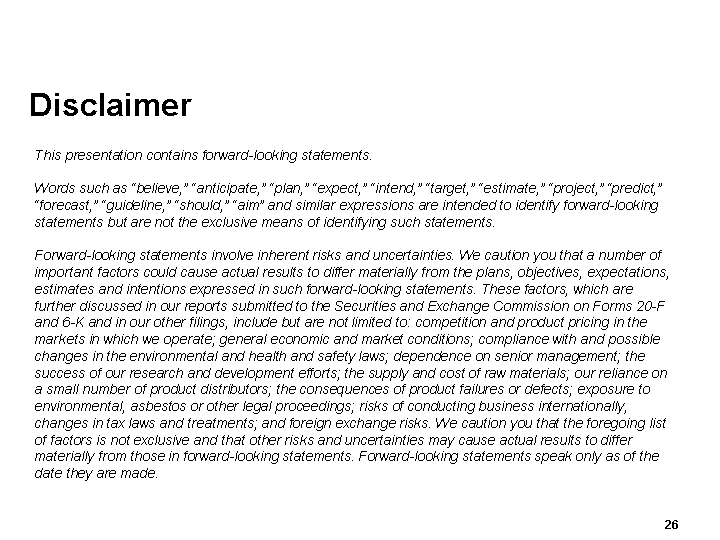
|
Disclaimer
This presentation contains forward-looking statements.
Words such as "believe," "anticipate," "plan," "expect," "intend," "target," "estimate," "project," "predict,"
"forecast," "guideline," "should," "aim" and similar expressions are intended to identify forward-looking
statements but are not the exclusive means of identifying such statements.
Forward-looking statements involve inherent risks and uncertainties. We caution you that a number of
important factors could cause actual results to differ materially from the plans, objectives, expectations,
estimates and intentions expressed in such forward-looking statements. These factors, which are
further discussed in our reports submitted to the Securities and Exchange Commission on Forms 20-F
and 6-K and in our other filings, include but are not limited to: competition and product pricing in the
markets in which we operate; general economic and market conditions; compliance with and possible
changes in the environmental and health and safety laws; dependence on senior management; the
success of our research and development efforts; the supply and cost of raw materials; our reliance on
a small number of product distributors; the consequences of product failures or defects; exposure to
environmental, asbestos or other legal proceedings; risks of conducting business internationally,
changes in tax laws and treatments; and foreign exchange risks. We caution you that the foregoing list
of factors is not exclusive and that other risks and uncertainties may cause actual results to differ
materially from those in forward-looking statements. Forward-looking statements speak only as of the
date they are made.
|
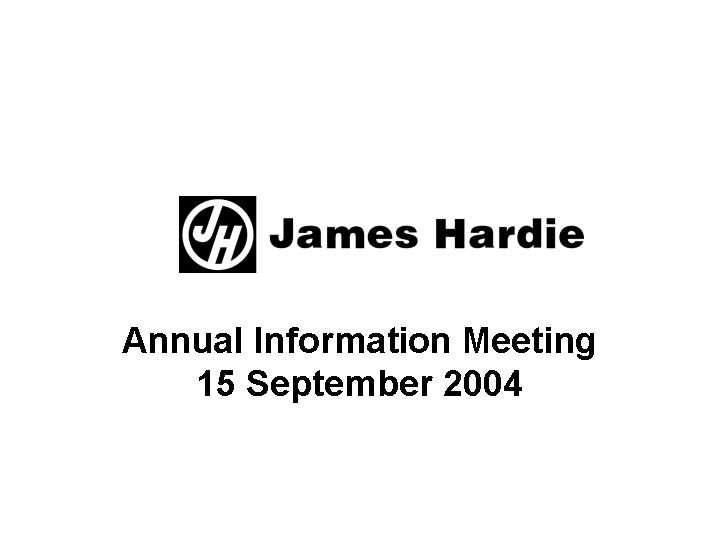
|
Annual Information Meeting
15 September 2004
|


























